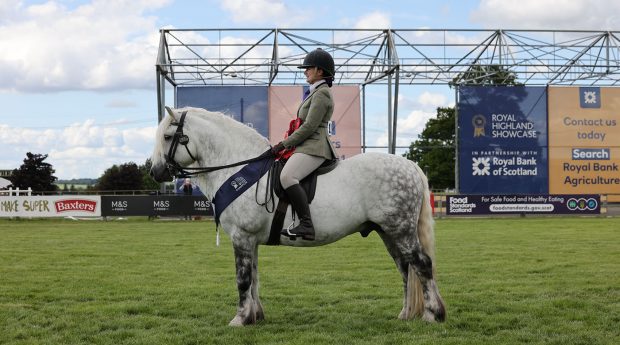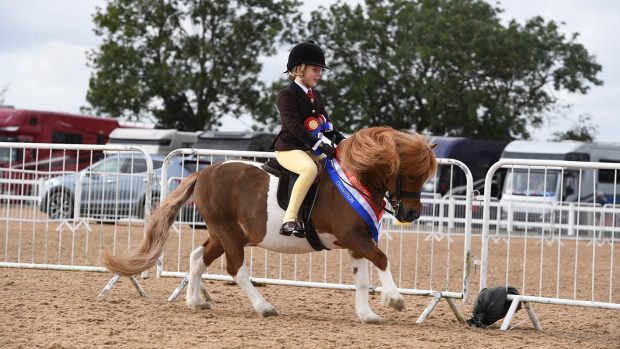If you’re hoping to buy a Dales pony for the show ring or to simply enjoy, then this guide on what to look for is the ideal starting point.
What is a Dales pony?
The Dales pony is one of the Britain’s native breeds. According to the Dales Pony Society (DPS), the Dales is a native of the upper dales of the eastern slopes of the Pennine range, from the High Peak in Derbyshire to the Cheviot Hills near the Scottish Border, where a lead mining industry flourished from Roman times until the mid-nineteenth century.
During the late 17th Century, the Scotch Galloway was the favoured breed for fast pack work.
The DPS says: “Suitable native mares ran with the breeding herds and it is recorded that farmers also liked to run a few Scotch mares with the native herds on the fell.
“The largest, strongest and most active ponies were chosen for pack work and were well fed to ensure fitness and speed. So it was that the black Galloways of the mixed herds eventually superseded the Scotch Galloway, and eventually became the Dales pony through a series of improvements from several sources.
“The Scotch Galloways were famous for their ‘peculiarly deep and clean legs, their qualities were speed, stoutness and sure-footedness over a rugged and mountainous country’. In turn, the Dales ponies became renowned for their great strength, iron constitution, endurance, and the ability to get over rough country fast.”
Dales ponies ideally stand between 14hh to 14.2hh, but there is no upper height limit on the breed.
Dales ponies can be registered as follows (credit DPS):
- Section A: By a registered, licensed stallion, and out of either a section A or a section B mare, and displaying correct markings.
- Section B: By a registered, licensed stallion and:
a) out of a section A or a section B mare, but displaying incorrect markings.
b) out of section C mare, and correct in type and colour. - Section C: By a registered, licensed stallion and out of section D mare, and correct in type & colour.
- Section D: Passed by two inspectors as being true to type, height and colour (closed 31 December 1971).
The Society also maintains a part-bred register.
Dales ponies are predominantly black but some are brown, bay, grey and, more rarely, roan. White markings, such as a star and/or a snip, and white to the hind fetlocks, are allowed. Ponies displaying more white than this are down graded from section A to section B.
Dales Pony Society breed standard
Head: Neat and pony-like. Broad between the eyes, which should be bright and alert. Pony ears slightly incurving. Long foretop of straight hair down the face.
Neck: Strong and of ample length. Stallions should display a bold outlook with a well-arched crest. Throat and jaws clean-cut. Long, flowing mane.
Shoulders: Well-laid, long, sloping shoulders with well-developed muscles. Withers not too fine.
Body: Short-coupled and deep through the chest, with well-sprung ribs.
Hindquarters: Deep, lengthy and powerful. Second thighs well-developed and very muscular. Tail well set on, not high, with plenty of long, straight hair reaching the ground.
Hocks: Broad, Flat and clean. Well let down with plenty of dense flat bone below.
Forearms: Set square. Short and very muscular, with broad, well-developed knees.
Feet, legs and joints: The very best of feet and legs, with flexible joints, showing quality with no coarseness. The cannons should display eight to nine inch (20.3cm — 22.9cm) of flat, flinty bone and well defined tendons. Pasterns should be nicely sloping and of good length. Ample silky feather on the heels. Large, round feet open at the heels, with well developed frogs.
Action: The Dales is defined by its flashy, energetic action. The knee and hock should be lifted and the hind legs should be flexed well under the body for powerful drive.
Dales ponies are popular all-rounders, succeeding in multiple disciplines. The DPS says: “Dales ponies were bred for a specific job in a harsh environment. When the job changed, they were successfully adapted for other uses, and today the ponies can demonstrate all the qualities and abilities which brought their forebears such renown.
“The combination of strength, agility, thrift, hardiness and high courage, with good conformation and a calm, intelligent nature, makes the Dales pony a first-class riding and driving pony with all the abilities of a true all-rounder.”
What should I look for in a Dales pony?
Anna Pennell and her family breed Dales ponies under the Nipna prefix. Ponies from the stud have won at all major fixtures as well as at breed shows. Their stallion Nipna Midnight Rambler was crowned supreme M&M champion at London International in 2023.
“Whatever pony I’m looking at I start with the quality of the feet and the lower limbs,” explains Anna. “They need to have quality bone with a good-sized, strong foot. Hocks and joints are so important to any breed.
“Working our way up the pony, I’d look for a good shoulder, especially if seeking a future ridden pony. If looking for a ridden animal, I’d like slightly longer pasterns, but not too long as they need to stand up to work. The angle of the pastern should also match the length of the shoulder. This gives them the true Dales trot and comfortable ride that they are known for.”
Anna also says that Dales ponies are known to be slow maturers compared to other natives, so going into a viewing with an open mind is essential: “Don’t expect most four-year-olds to be ready to go out and do it all. I would not be worried if a six or seven-year-old was immature, either, as most of them don’t come into their prime until they are at least eight years old, but some take even longer. Of course, there are the odd exceptions to this rule, but they are generally late maturers that require time and patience to develop both mentally and physically.
“The action of a Dales should be akin to a wagon wheel,” Anna continues. “They should move up and travel forwards. We don’t want a pony to ‘potato-mash’ up and down, or daisy cut. The best of the best tend to move from the get go, but if I saw a nice two or three-year-old with quite average movement I would not write it off. They can often develop their action under-saddle and it can take time for them to strengthen and become more powerful.”
When asked if prospective buyers should look for a section A or a section B Dales, Anna advises: “I have no issues with section Bs — there are successful section Bs out and about on the circuit. If you want to show then a pony with four white socks and a blaze is not ideal, but they are extra markings at the end of the day, not a conformational defect. If you don’t want to show, a section A or a section B could be suitable for you as Dales ponies generally make super all-rounders that can do anything and everything.”
Where to buy a Dales pony
Online horse for sale sites have Dales ponies advertised when they are available, but Anna warns that as the Dales is a rare and in demand breed, they are rarely advertised on the open market.
“A good starting point is to get in touch with the DPS,” says Anna. “Then, it’s always a good idea to go to breed shows and speak with breeders who might have stock currently available or coming up for sale in the near future. I would not expect many ponies to be advertised on sales sites throughout the year, though; once people get hold of a Dales they rarely want to let them go!”
How much does a Dales pony cost?
The price of a Dales pony will depend on several factors, including breeding, age and competition record.
“We have sold colt foals for around £2,000 and filly foals for around £3,000,” Anna says. “If you have a rising four or five-year-old ready for breaking you could expect them to sell for between £4,000 and £5,000, perhaps more. An established show pony could easily fetch between £10,000 and £15,000. This is an estimate for ponies good enough to show, though you can certainly find ponies for less, and for more.”
What happens when I’ve agreed to buy a pony?
If you decide to purchase a pony a pre-purchase vetting is strongly recommended. It’s important to let the vet know prior to the vetting what you intend to use the pony for so they can assess it accordingly.
“I would have an older pony put through a two-stage vetting, at least,” Anna says. “But a lot of buying a pony is about common sense. If you don’t feel you are experienced enough to make a decision on a pony’s health and soundless, always seek professional advice.”
For more information, you can read H&H’s ultimate guide to buying a horse.
- To stay up to date with all the breaking news from major shows throughout the year, subscribe to the Horse & Hound website
You may also be interested in:

The Dales pony: the hardy, hairy ponies who can turn a hoof at any job

‘He does the lot, even half pass’: amateur’s joy as her dressage star leads Dales field at HOYS

‘What a result for the breed’: Dales stallions take top two spots in M&M supreme at London International

Dales stallion performs like a ‘true superstar’ to be crowned HOYS M&M champion

Subscribe to Horse & Hound magazine today – and enjoy unlimited website access all year round




